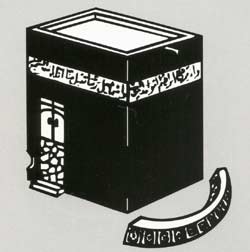>
The Construction of the Holy Ka'bah by Al-Hajjaj
Considering the architectural contribution of AI-Hajjaj to the building of the Holy Ka'bah as a comprehensive, independent work is an exaggeration and an error committed by historians. In fact, he did not contribute to the building of the Holy Ka'bah, but demolished parts of the additions made by Ibn AtZubair.
The building of Ibn Al-Hajjaj.
The right figure was designed by the calligrapher Al-Sheikh Muhammad Tahir AI-Kurdi. |
 |
 |
In the year 74 H., AI-Hajjaj wrote to Abdul Malik Ibn Marwan that Abu Khubaib Abdullah lbn At-Zubair had made additions to the building of the Holy Ka'bah, and fixed another door. Abdul Malik instructed AI-Hajjaj to close down the western door added by Ibn Al-Zubair, and also to pull down what had been added to the Hijir. Al-Hajjaj was further commanded to spread out the surplus stones on the floor as had been done during the Prophet's time. He demolished six cubits and a hand span on the side of AI-Hijir, and built it on the foundations of Quraish. He spread the floor with the remaining stones, and closed the western door at the back of the Holy Ka'bah. He removed the part under the threshold of the eastern door which was four cubits and one hand span high. He left the rest of the building as it was, but he added a wall in the Hijir. He closed down the west door at the back of the Holy Ka'bah and raised the eastern door to its former position under Quraish. All this was built by AI-Hajjaj in addition to the staircase inside the Holy Ka'bah and the two present doors.
The time lapse between the building by Quraish and the building by Ibn AI-Zubair was eighty years. The work done by Ibn Al-Zubair was nine or ten years before that of Al-Hajjaj. The Holy Ka'bah remained as it was ever since AI-Hajjaj demolished the part of the Hijir added by Ibn AI-Zubair, closed its western door and raised the eastern door, up to the year 1039 H. This meant that the Holy Ka'bah was not subject to any destruction or ruin for nine hundred, sixty-six years, except for some slight maintenance.
In 1039 H., unprecedented rains flooded the Holy Mosque and led to the collapse of most of the Sacred House. Then followed the eleventh reconstruction by the Ottoman Sultan, Murad Khan, in 1040 H. |
